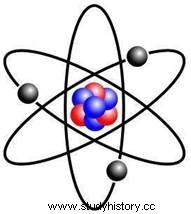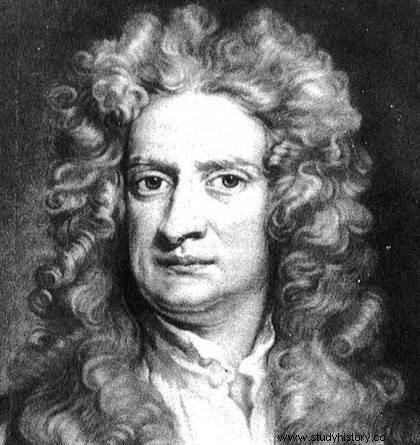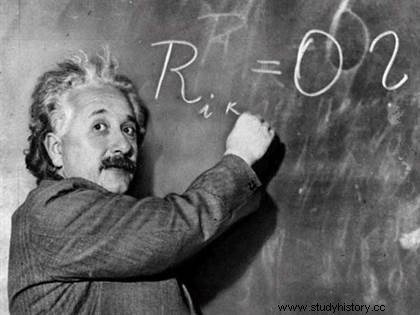 The History of Physics Its main objective is to retrace the various discoveries made by physicists since prehistoric times. Throughout time, men have always wanted to improve their understanding of the universe. Using observations and mathematics to precisely describe everyday phenomena, many physicists have taken turns to increase our knowledge. Thus, through the ages, we will show what have been the major developments that have made it possible to found our current knowledge of the universe.
The History of Physics Its main objective is to retrace the various discoveries made by physicists since prehistoric times. Throughout time, men have always wanted to improve their understanding of the universe. Using observations and mathematics to precisely describe everyday phenomena, many physicists have taken turns to increase our knowledge. Thus, through the ages, we will show what have been the major developments that have made it possible to found our current knowledge of the universe.
At the beginning of the history of physics
We know that physics only takes root in prehistory and antiquity. Thanks to archaeologists, we know for sure that prehistoric people were good observers. Monuments, such as that of the megalithic "Stonehenge" provide us with proof of this. Prehistoric men knew this ardent desire to know more about our universe and tried to reproduce certain phenomena, they thus founded the first element of a scientific approach which is observation.
Also, the first objects used to measure time saw their appearance during this period of our history. The bone of Ishango, the bone of the Blanchard shelter, but also Stonehenge, and Carnac were the first instruments that could measure time. This is the beginning of physics:the description of certain astronomical mechanisms. The physics of antiquity, on the other hand, is known to us in a much more precise way. Time was also an important concern. The gnomon, the clepsydra and the sundial are legacies of antiquity.
 But beyond the measurement of time, Greek knowledge was formed with physicists such as Archimedes, Thales of Miletus, or Erastosthenes. Interested in matter and its phenomena, most of these philosophers have thus advanced our understanding of the universe. The word “atom” comes from the Greek “atomon” meaning “indivisible”. Indeed, Democritus (-460 - -370 BC) assumes that matter is made up of particles separated by vacuum. These particles, which are said to be indivisible because they are considered the smallest elements, will be called atoms. "Finally, the bodies that we see as hard and massive owe their coherence to more hooked, more intimately linked corpuscles... On the contrary, it is smooth and round corpuscles which form bodies of a liquid and fluid nature" he affirms . Archimedes (-287 - -212 BC) is designated today as the founder of static mechanics:he is at the origin of many traction machines, but also some of war, such as the catapult.
But beyond the measurement of time, Greek knowledge was formed with physicists such as Archimedes, Thales of Miletus, or Erastosthenes. Interested in matter and its phenomena, most of these philosophers have thus advanced our understanding of the universe. The word “atom” comes from the Greek “atomon” meaning “indivisible”. Indeed, Democritus (-460 - -370 BC) assumes that matter is made up of particles separated by vacuum. These particles, which are said to be indivisible because they are considered the smallest elements, will be called atoms. "Finally, the bodies that we see as hard and massive owe their coherence to more hooked, more intimately linked corpuscles... On the contrary, it is smooth and round corpuscles which form bodies of a liquid and fluid nature" he affirms . Archimedes (-287 - -212 BC) is designated today as the founder of static mechanics:he is at the origin of many traction machines, but also some of war, such as the catapult.
But it is above all for his work on the mechanics of fluids that he is known. Having shouted "Eureka" according to the legend, he discovered the properties of bodies immersed in a fluid, and thus stated the "principle of Archimedes":Any body immersed in a liquid (or a gas) receives a thrust, which is 'exercises from bottom to top, and which is equal to the weight of the volume of liquid displaced. This thrust will be called the "Archimedean thrust". We will not quote here all the physicists of Antiquity, but it is nevertheless advisable to be interested in Eratosthenes. The latter calculated the circumference of the Earth from menhirs and using simple mathematics.
Indeed, supposing the sun's rays to be parallel, he manages to measure at noon in Alexandria the angle of the sun's rays with the vertical (menhir) and finds 7°. At the same time in Syene, a city located almost on the same meridian, the rays of the Sun do not form any angle in a well. Using a proportionality relationship, he deduces the Earth's circumference of 40,349 km, an error of 10% compared to the value measured with precision today. Thus physics progresses and knowledge accumulates through observation, the formulation of hypotheses, and the development of theories using mathematical tools.
Advances in physics
 The Middle Ages set in, and wars multiplied. Invasions, conquests, wars ... and the accumulated Greek knowledge of Antiquity is lost except for a few philosophers, such as Boethius, who preserve through the Quadrivium some scientific heritages of Antiquity. While the West is plunged into a period of oblivion, the Arab-Muslim civilization continues the work undertaken by the Greeks, in particular by preserving the writings of discoveries, and by resuming these works to deepen them and thus found a civilization of knowledge. :this is the golden age of Arab-Muslim progress.
The Middle Ages set in, and wars multiplied. Invasions, conquests, wars ... and the accumulated Greek knowledge of Antiquity is lost except for a few philosophers, such as Boethius, who preserve through the Quadrivium some scientific heritages of Antiquity. While the West is plunged into a period of oblivion, the Arab-Muslim civilization continues the work undertaken by the Greeks, in particular by preserving the writings of discoveries, and by resuming these works to deepen them and thus found a civilization of knowledge. :this is the golden age of Arab-Muslim progress.
The invention of zero by the Arabs caused an upheaval in the mathematical sciences and allowed progress in the field, as illustrated by algebra and scientists such as Averroes (1126-1198). Astronomy is also deepened by the invention of a first water telescope by the physicist astronomer Alhazen (965-1039). The latter manages to explain optical phenomena such as the Moon which appears larger in the sky at certain times, or even why the Moon shines. He is also the first to speak of the phenomenon of refraction, an idea that will be taken up by physicists in the following centuries. In mechanics, Alhazen states the principle of inertia, which will later be taken up by Galileo, and also speaks of the attraction of masses, an idea which will mainly be taken up by Isaac Newton centuries later. The Renaissance saw many scientists revolutionize the world of physical science.
Comes Galileo (1564-1642), the physicist astronomer who became very famous for many inventions such as the astronomical telescope. His work in dynamics taught him to understand the movement of the planets. Also, it states the principle of inertia which states that if an object is subjected to no force or to forces whose resultant is zero, then the body in question is either at rest or in uniform rectilinear motion. This principle will constitute a few years later the first law of Newton. René Descartes (1596-1650), meanwhile, works more on optics and mathematically expresses the law of the refraction of light, and obviously that of reflection.
 But the major progress of the 17th century was surely the work of the scientist Isaac Newton (1643-1723). He works in many fields, such as optics, mechanics and mathematics, and revolutionizes our understanding of the Universe. Newton continues the work of Descartes (and Snell) on the refraction of light:he shows that a prism breaks up light into several colors, and that it is these colors that form white light. He also studies diffraction and will be the inventor of Newton's telescope which will allow better sight and visibility than Galileo's astronomical telescope.
But the major progress of the 17th century was surely the work of the scientist Isaac Newton (1643-1723). He works in many fields, such as optics, mechanics and mathematics, and revolutionizes our understanding of the Universe. Newton continues the work of Descartes (and Snell) on the refraction of light:he shows that a prism breaks up light into several colors, and that it is these colors that form white light. He also studies diffraction and will be the inventor of Newton's telescope which will allow better sight and visibility than Galileo's astronomical telescope.
In mechanics, Isaac Newton explains the movement of bodies mathematically using vectors to model forces. Thus he establishes three laws which will be called later "Newton's laws" and manages to explain the functioning of gravity by stating the law of universal gravitation, which he will publish in his work "The principles of philosophy natural" thanks to his friend the astronomer Halley (1656-1742). Finally Leibniz (1646–1716) was an important physicist of the time:his theoretical discoveries on the conservation of energy and the theoretical modeling of spatial and temporal dimensions will have been of great use to the scientists who will follow.
Post-Newtonian physical sciences
We better understand energy and dynamics:kinematics and dynamics, will then create a branch that unites the two sub-domains:thermodynamics. As its name suggests, which comes from the ancient Greek “thermos”:heat, and “dunamis”:power (hence the name dynamic), this branch of the physical sciences relates movement and energy ( heat is only a means of transporting energy). With this new branch of physics, industry will make progress (in the industrial age precisely) and steam engines will develop.
Another new branch also appeared:electromagnetism, with Maxwell (1831–1879). This new branch unifies electricity with magnetism, and this with simple experiments (as well as in theory with mathematics):an electric current circulating in a wire generates a magnetic field. It is the movement of free electrons that creates a magnetic field, at the same time as an electric current.
But the most important discovery of the century will undoubtedly be that of the measurement of the speed of light using the interferometer by two Nobel Prize winners:Edward Morley (1838-1923) and Albert Abraham Michelson (1852-1931) . They note that the speed of light is the same in all the reference frames of the same medium, a discovery which creates an upheaval in the dynamics. Indeed, an observer moving at a high speed, and an observer being motionless, in a certain frame of reference, will see a photon pass at the same speed, which is contrary to the dynamics of physics:an observer moving in the same direction of the photon at a high speed, should see it progress slower than an observer at rest (in a certain frame of reference) [1] . This can only be explained with the principle of length contraction, of which Fitzgerald (1851-1901) and Lorentz (1853-1928) originated. Classical mechanics are thus contradicted.
Einstein revolutionizes physics
 It will be necessary to wait for Einstein (1879-1955) to reconcile this surprising discovery with mechanics. In 1905, he published his special theory of relativity which proved that if the speed of light does not change, a movement follows from a deformation of space and time. Thus he shows that space and time are not constants, but expand and contract, hence the imagined experience of the Langevin twins (1872-1946) whose old age would be different depending on whether they had done a trip at high speed or not (relative to a certain benchmark) [1].
It will be necessary to wait for Einstein (1879-1955) to reconcile this surprising discovery with mechanics. In 1905, he published his special theory of relativity which proved that if the speed of light does not change, a movement follows from a deformation of space and time. Thus he shows that space and time are not constants, but expand and contract, hence the imagined experience of the Langevin twins (1872-1946) whose old age would be different depending on whether they had done a trip at high speed or not (relative to a certain benchmark) [1].
The general relativity developed between 1907 and 1915 by Einstein will reconcile special relativity with a theory of gravitation. Indeed Albert shows that according to him gravitation is only a deformation of space-time. Like a ball placed on a sheet of rubber, the deformation of the latter would generate an attraction because a body follows the gravitational lines called geodesics.
General relativity will reduce the field of application of Newtonian mechanics, the latter no longer working for bodies moving at very high speeds. It will also lead to new concepts, such as the black hole, which have recently been detected. Also the physicist Hubble (1889-1953) will show that the galaxies move away from each other (contrary to what Newtonian mechanics could lead us to believe) hence the idea of the expansion of the Universe, continued to an event that will be named "Big Bang".
In the field of quantum mechanics, Ernest Rutherford (1871-1937) will lead to extraordinary discoveries in nuclear physics. He discovers ionizing rays such as radioactivity, alpha and beta rays. His experience with the gold atom will highlight the existence of a nucleus bringing together the positive charges of the atom and responsible for its mass.
Physics nowadays
Physics therefore has solid foundations to allow new discoveries and new inventions. Still remains to be resolved the incompatibility between quantum mechanics and general relativity, which are radically different. All the discoveries of the last two hundred years seem to lead to the same point, to converge, hence the idea of a theory of everything, and of a master equation which is currently the subject of intense research by physicists. . Computers and machines allow physics to move faster with more precision.
Recently the opening of the LHC ("Large Hardron Collider" or "Large Hadron Collider") of CERN ("European Council for Nuclear Research", officially:"European Organization for Nuclear Research") will make it possible to discover the secrets of the matter and perhaps even to reconstitute the Universe at its beginnings, in short, it promises us many surprises. Thanks to mathematics, computer science, and technology, the physical sciences continue to progress, and the history of this magnificent science continues to be written...
[1] We always talk about movement with respect to a reference frame (solid considered as fixed)
Bibliography
- Jean Rosmorduc, A history of physics and chemistry. Science Points, 1985.
- Jean Perdijon, History of physics. Dunod, 2008.
